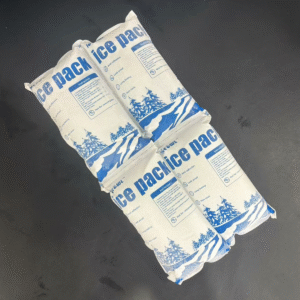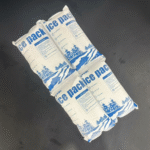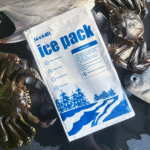Pacote de gelo seco para transporte de vacinas: Como escolher e usar
Garantir que as vacinas permaneçam à temperatura correta durante o transporte é uma parte crítica da logística dos cuidados de saúde. Em 2025, bolsas de gelo seco continuam a ser uma ferramenta vital na manutenção de temperaturas ultrabaixas para vacinas, como as vacinas de mRNA COVID-19, que requerem refrigeração entre -70°C e -80°C. Este guia oferece uma visão geral abrangente de como selecionar as bolsas de gelo seco certas, manuseie e armazene-os com segurança, e cumprir os regulamentos mais recentes para garantir a segurança, transporte eficiente de vacinas.
-
Por que são bolsas de gelo seco essenciais para o transporte de vacinas?
-
Como você seleciona a bolsa de gelo seco certa para sua remessa?
-
Que precauções de segurança você deve tomar ao manusear gelo seco para envio de vacinas?
-
Como armazenar e usar gelo seco com segurança durante o transporte?
Por que as bolsas de gelo seco são essenciais para o transporte de vacinas?
Bolsas de gelo seco são essenciais para o transporte de vacinas que requerem temperaturas ultrabaixas. Vacinas como a vacina Pfizer-BioNTech COVID-19 devem ser mantidas entre -70°C e -80°C, tornando o gelo seco uma ferramenta essencial. O gelo seco sublima a -78,5°C, o que é ideal para garantir que as vacinas permaneçam dentro da faixa de temperatura exigida durante o transporte.
Usando bolsas de gelo seco, você pode estender a vida útil das vacinas, evitando a exposição a flutuações de temperatura que possam comprometer sua eficácia. Isso garante que as vacinas cheguem ao seu destino em ótimas condições, reduzindo o risco de imunizações ineficazes.
O que torna o gelo seco ideal para remessas de vacinas?
O gelo seco oferece diversas vantagens para o transporte de vacinas:
-
Mantém Baixas Temperaturas Consistentes: O gelo seco é perfeito para armazenamento ultrafrio, especialmente para vacinas que requerem temperaturas abaixo de zero.
-
Nenhum resíduo líquido: Ao contrário do gelo regular, gelo seco sublima em gás, não deixando nenhum líquido que possa danificar a embalagem ou causar vazamentos.
-
Resfriamento de longa duração: O gelo seco dura mais do que pacotes de gel ou gelo, tornando-o ideal para remessas internacionais e de longa distância.
| Recurso | Pacotes de gelo de gelo seco | Pacotes de gel ou gelo normal | O que isso significa para você |
|---|---|---|---|
| Faixa de temperatura | -78.5°C | 0° C a -5 ° C. | Garante que as vacinas permaneçam congeladas ou resfriadas |
| Taxa de sublimação | 5-10 libras cada 24 horas | Derrete em líquido | Sem vazamentos ou resíduos |
| Durabilidade | Dura mais durante o trânsito | Vida útil mais curta | Confiável para remessas longas |
Dicas práticas de uso
-
Para remessas de longa distância: Use bolsas de gelo seco maiores ou múltiplas para manter uma temperatura consistente durante transporte prolongado.
-
Para diferentes tipos de vacinas: Vacinas diferentes requerem configurações de temperatura diferentes. Certifique-se de selecionar a solução de gelo seco apropriada com base no limite de temperatura específico da vacina.
-
Para embalagens sensíveis: Combine gelo seco com contêineres isolados para otimizar o resfriamento e proteger as vacinas.
Caso real: Uma organização global de saúde relatou que o uso de bolsas de gelo seco para o transporte de vacinas melhorou a eficiência do envio em 25%, garantir que as vacinas cheguem a tempo e dentro da faixa de temperatura exigida.
Como você seleciona o pacote de gelo seco certo para remessas de vacinas?
Escolher a bolsa de gelo seco correta é crucial para manter a segurança das vacinas. Considere estes fatores ao selecionar uma solução de gelo seco para transporte de vacinas:
Principais considerações para seleção de gelo seco
-
Duração do envio: Remessas mais longas exigem mais gelo seco. Pacotes maiores ou vários pacotes menores serão necessários para viagens mais longas.
-
Tamanho da embalagem: O tamanho do contêiner de transporte afeta a quantidade de gelo seco necessária. Certifique-se de que o contêiner possa acomodar os pacotes, mantendo o isolamento.
-
Temperatura Externa: Se a remessa for exposta a temperaturas mais altas, garantir que gelo seco suficiente seja usado para manter o frio necessário.
Recomendações para a escolha de bolsas de gelo seco
-
Para tempos de trânsito mais curtos, pacotes menores de gelo seco podem ser suficientes. Para remessas mais longas, opte por pacotes maiores ou múltiplos.
-
Calcule os requisitos de gelo seco com base na duração da remessa e nas necessidades de temperatura das vacinas.
-
Usar recipientes isolados projetado para funcionar eficientemente com gelo seco para minimizar o desperdício e garantir temperaturas estáveis.
Armazenamento e manuseio seguros de gelo seco durante o envio de vacinas
O armazenamento e o manuseio adequados do gelo seco são essenciais para a segurança. O gelo seco pode representar riscos como congelamento e asfixia se for mal manuseado, por isso é crucial seguir as diretrizes de segurança.
Diretrizes de segurança para manuseio de gelo seco
-
Ventilação: Sempre armazene gelo seco em uma área bem ventilada para evitar o acúmulo de dióxido de carbono.
-
Equipamento de proteção: Use luvas isoladas e roupas de proteção para evitar queimaduras pelo frio e pelo frio.
-
Disposição: Descarte o gelo seco não utilizado, permitindo que ele sublime em um espaço ao ar livre. Nunca descarte gelo seco em recipientes lacrados.
| Protocolo de Segurança | Descrição | Sua ação |
|---|---|---|
| Ventilação | Armazene em uma área bem ventilada | Evite espaços confinados |
| Equipamento de proteção | Use luvas e óculos isolados | Evite queimaduras de frio ou congelamento |
| Métodos de descarte | Permitir que o gelo seco sublime ao ar livre | Garanta o descarte seguro ao ar livre |
Dicas práticas de segurança no transporte
-
Rotulagem adequada: Rotular embalagens contendo gelo seco para alertar destinatários e transportadores.
-
Contêiner de transporte: Use resistente, recipientes ventilados para evitar o acúmulo de gás e proteger as vacinas.
-
Treinamento: Garantir que o pessoal seja treinado no manuseio de gelo seco e nos procedimentos de segurança.
2025 Desenvolvimentos e tendências em gelo seco para transporte de vacinas
A indústria da cadeia de frio continua a inovar, tornando o transporte de gelo seco ainda mais seguro e eficiente. Aqui estão alguns 2025 tendências:
-
Sensores de temperatura inteligentes: Sensores inteligentes rastreiam a temperatura das remessas em tempo real, garantindo que as vacinas permaneçam na temperatura correta.
-
Blockchain para transparência: A tecnologia Blockchain melhora a rastreabilidade, tornando mais fácil garantir que as vacinas sejam armazenadas e transportadas corretamente.
-
Soluções ecológicas de gelo seco: Mais empresas estão adotando a produção de gelo seco neutro em carbono para cumprir as metas de sustentabilidade.
Principais insights do mercado
Espera-se que o mercado de logística da cadeia de frio atinja $600 bilhão por 2025. À medida que cresce a procura por vacinas e produtos biológicos, soluções de gelo seco continuarão essenciais para garantir um transporte seguro e eficaz.
Perguntas frequentes
Q1: Quanto tempo dura o gelo seco no envio de vacinas?
Gelo seco normalmente dura 24-48 horas, dependendo do tamanho da embalagem e do isolamento do recipiente. Para durações mais longas, pacotes maiores ou vários pacotes podem ser necessários.
Q2: O gelo seco é seguro para transportar todos os tipos de vacinas??
O gelo seco é usado para vacinas que exigem temperaturas ultrabaixas, como vacinas de mRNA. Não é adequado para vacinas de rotina que precisam ficar entre 2°C e 8°C.
Q3: Como o gelo seco deve ser armazenado durante o transporte?
O gelo seco deve ser armazenado em recipientes bem ventilados para permitir que o gás escape e evitar o aumento de pressão. Sempre use recipientes projetados para transporte de gelo seco.
Resumo e recomendações
Bolsas de gelo seco são cruciais para manter as vacinas na temperatura correta durante o transporte. Escolha o tamanho certo da bolsa de gelo seco, calcular os requisitos de gelo seco, e siga os protocolos de segurança para garantir que as vacinas cheguem com segurança.
Etapas de ação
-
Avalie os requisitos de temperatura e duração para suas remessas de vacinas.
-
Treine a equipe sobre o manuseio seguro do gelo seco.
-
Invista em dispositivos de monitoramento de temperatura para garantir condições ideais durante todo o transporte.
Sobre Tempk
E tempk, somos especializados em fornecer soluções de gelo seco de alta qualidade para transporte de vacinas. Nossa tecnologia inovadora garante que as vacinas sejam entregues no prazo e dentro da faixa de temperatura exigida. Contate-nos hoje para soluções personalizadas e para saber mais sobre nossos serviços.
























